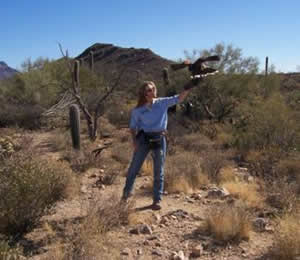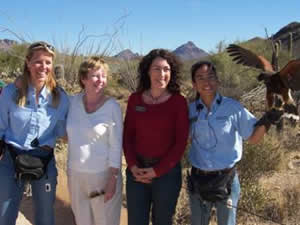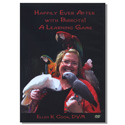Tucson, Arizona, February 2, 2006
We're standing on a gently sloping foothill with Tucson's jagged volcanic peaks behind us, looking across the vast, flat Avra valley far below. The hills beyond that valley are in Mexico. The desert sky is a brilliant, piercing blue, filling the eyes with light. The mild warmth of the winter sun is welcome. This is Saguaro National Park. Giant saguaro cacti, their upraised arms frozen in mid-gesture, dot the rolling terrain around us and march up the slopes of the mountains behind us like some strange army. Between and around them, desert-adapted plants thinly coat the sandy ground: mesquite and brittlebush, palo verde, prickly pear and ocotillo. To my temperate-climate eyes the plant life might as well be from another planet.

Someone points out a hawk, sitting on the top of a saguaro perhaps fifty yards away. Just as I spot the bird, it lofts itself into the air and flies closer to us, landing on the top of another saguaro near by. We are looking at the bird, and the bird is having a look at us. It's a Harris's Hawk, and it's Harris's Hawks we've come to see.
Most hawks are speckled with light and dark brown, in various patterns that change with age, region, and gene pool. That can make identification difficult for the amateur birder like me. Harris's Hawks, conveniently, are unmistakable: a solid, dark brown all over, with copper-colored shoulders and a handsome dark brown and white-banded tail. They fan the tail when they land, wag it when they are excited, and spread it often in their acrobatic aerial maneuvers. It's the Harris's tribal flag, identifying them even at considerable distance.
Harris's Hawks are unique in another way. Most raptors are solitary as adults; these hawks live in family groups. See one, look for more: and sure enough, here comes another, a larger bird, therefore a female, landing on the top of another saguaro. Now comes a third, and then a fourth. The last one barges onto the saguaro top the first bird is sitting on. "I deserve to perch there!" The bird already in place knocks the newcomer away with a well-timed kick. Then all four birds hop into the air and circle, trying out different perches here and there; musical chairs on the saguaros.
Harris's Hawks are territorial. Each family jointly defends a piece of land that, in good Harris's Hawk country, will be about a mile square; what ranchers call a section. They want a water supply, an abundance of rabbits, rodents, and other prey, and long sightlines to sport interlopers, such as other hawks, and dangers, such as coyotes and eagles. We are in the middle of this group's highly desirable territory.
We are also in the middle of the grounds of the Arizona-Sonora Desert Museum, a unique collection of living plants and animals from the terrain around us. Some of the museum staff and volunteers attended ClickerExpo in Tucson this past weekend. They invited the ClickerExpo staff to visit their unique facility, and several of us stayed over an extra day to do so. ClickerExpo contributions to today's Harris's Hawk watchers consist of event manager Jodi Smith-Bennett, Cheryl Spencer from the registration desk, Sandra and Tom from the ClickerExpo store, Canadian TAGteacher and faculty member Joan Orr and her family, and me.
We're not the only ones here to see the Harris's Hawks. About sixty other museum visitors have joined us at the appointed spot, a widening in the path through the desert. A visiting camera crew is crouched amid the prickly pears photographing the birds, and a museum docent with a portable loudspeaker is telling us about Harris's Hawk behavior and natural history.
Now the female hawk departs purposefully toward the east, soaring just above the bushes, and landing with her wings outspread on a sandy patch a hundred feet away. She is mostly out of sight but I can see she's mantling, or holding her wings open, and bending her head to the ground. Her breeding partner joins her, and, briefly, the other two birds. Then they all rise and come back to land together in the bare branches of a nearby tree. For a moment all four are in one place. The senior pair actually sit side by side, amicably touching shoulders.
We couldn't see what took them to that sandy spot but I suspected it was breakfast. The narrator on the loudspeaker had told us that Harris's Hawks feed on rabbits, birds, ground squirrels, and other small rodents. She tactfully does not mention that the birds might be hunting—and killing and eating—some small animal at this very moment.
This wonderful chance to watch some unusual bird behavior in the wild is not an accident; it's a current feature of the museum's educational offerings, called the Raptor Free Flight. Every day, at 10:30 a.m. and 1:30 p.m., the museum's animal behaviorist, Sue Tygielski, Ph.D., and her team display the behavior and activities of various desert birds, free-flying, for visitors. The birds are the focus; you will hardly notice the trainers. And at 1:30 it is the Harris's Hawks.
Read Karen Pryor's articles on falconry:
CLICK: Falconry and Modern Operant Conditioning
Come Back, But Don't Come Down: An Advanced Exercise in Cueing
Right now Sue Tygielski and Marta Hernandes are crouching more or less out of sight among the bushes, communicating with each other by radio headsets. They are not interfering with the birds, but they are, from time to time and very unobtrusively, reinforcing them. Sue stands up and looks across the crowd. One of the hawks flies toward her. The bird coasts in on wide-spread wings right over our heads, almost within reach; we hear the feathers rustle and feel the wind of its passing. The crowd exclaims. Then another bird soars right over us. It will happen several times, and it is an exciting experience each time.
These birds don't seem to mind being around people, at all. Several years ago when the female was just under a year old, the two males made such pests of themselves during the breeding season that she took to landing on the path and standing around among the spectators, just to get some peace and quiet! This happened not through aversives of any kind but by selectively reinforcing incompatible behavior: Join the spectators, nothing happens. Sit on a cactus, get a treat.
As another bird soars over the heads of the crowd, Sue "clicks" the bird in midair, not with a sound but with a cue for another behavior. She has cued the bird to land on a specific dead palo verde tree nearby. The cue is her glance; the hawks have learned to go where the trainer is looking. The bird lands in indicated spot, and Sue, turning her back to the audience, quietly delivers a treat.
Sue did not reward the gliding bird for coming close to the crowd, but rather for staying far enough away. These birds often hunt stealthily by flying very low to the ground. Left to themselves, Sue tells us later, the birds seem to enjoy using people as an obstacle course, flying through the crowd rather than over it. It frightens some people, and holds some risk of injury for both birds and spectators (especially children, who might move unpredictably into the flight path). So the trainers, using cues as the bridging signal, shape and maintain fly-ins at a suitable height and a brisk speed.
Now all four birds are perched near Sue in a low, bare-branched tree. Sue reinforces the youngest male, still a bit inexperienced, for joining the group. After eating his treat he tries once more to sit where the senior male has chosen to sit. The nerve! The two males have a splendid midair argument, grappling with their bright yellow feet, locking talons, tumbling earthward in a rush of beating wings, and flying apart just before they hit the ground. This dramatic scene takes place right in front of us, not twenty feet away. It's like stepping into an Audubon painting.
The young male now stays on the ground for a while, striding about on his long yellow legs. Most raptors are rather awkward on a flat surface, but this fellow looks at the moment amazingly terrestrial, rather like the ground-loving Caracaras I have often seen in Chile. The narrator confirms that impression. Sometimes, she tells us, during a Harris's family hunt, a rabbit being chased simultaneously from several directions at once will take refuge in a dense patch of brush. Then one bird, usually the male with the lowest status (thus the most expendable should a coyote show up) lands on the ground and walks or crawls into the brush to flush the rabbit. Junior here seems highly capable of that feat of daring.
Now, apparently, it is time to end today's Raptor Free Flight. Sue picks up the young male on her glove. At a cue invisible to me, the other three birds loft into the air and sail away, disappearing over the crest of the nearest hill, going home. Sue walks after them with the young bird on her fist (later she explains that he hasn't quite got the hang of the "come home" cue yet, so he still gets carried home). The narrator announces that one of the trainers will be back shortly, with a hawk in hand, and invites us to stay and ask questions. As we wait for the trainers to return, the ClickerExpo group all agree that it's been one of the most thrilling animal shows we've ever seen.
But falconers have been training raptors for thousands of years. What makes this so different?

At ClickerExpo, and in my monthly letters, I talk about the schism between the two kinds of animal behaviorists: the behavioral biologists, who study evolutionary aspects of behavior, and the behavior analysts, who study learned or acquired behavior. I have often spoken about feeling as if I've been standing on a bridge all my life, with a foot in each camp, trying to encourage each side to cross over. The two camps don't talk to each other much, and very few practitioners combine the two sciences routinely, using each science to facilitate the other.
But here we have an example of the merging of the two sciences. Bird shows with free-flying birds were pioneered by trainer Steve Martin and are now popular attractions in zoos. In these shows, each hawk, owl, or parrot involved is exhibiting trained behavior, solely: often what zoo trainers call "A to B's," that is, flying from place A to place B on cue. It is wonderful to see these marvelous zoo creatures flying at all; but they are not just zooming around doing whatever they would do on a normal Monday at home—which is what these Harris's Hawks are doing.
This is indeed a view from the bridge. Dr. Tygielski and her team are using their understanding of the birds' ethology to enable us to have incredible view of complex social behavior. They are also using highly sophisticated reinforcement techniques to keep the birds around, and to care for and protect the birds—without any of the coercive techniques of traditional falconry. While aversives are not a big factor in falconry—none of the falconers I've met would dream of punishing a bird—food deprivation is pretty important. If you are getting your bird to come back to you solely by showing it food, that bird better be pretty hungry, hungry enough to give up the pleasure of flying free; and that means monitoring weight very closely, sometimes at the delicate point between hungry and starving.
The Desert Museum's free-flying raptors, on the other hand, are kept at normal weight. They are trim, muscular, glossy, and in fabulously good condition, like really healthy wild birds. The trainers don't mind if the animals do some hunting on their own. The birds still want the treats because they "win" them by their own learned skills. Earning reinforcers, for these birds, is a thrill, not a necessity. And, like us, they enjoy that experience of success.
For the hawks, as for dolphins that work with humans in the open ocean, there's another great benefit to having some reliable humans on their side: safety. I've seen dolphins I was responsible for, swimming around at liberty under the docks at Sea Life Park, jump back into their pens when a shark shows up. Here, Sue tells me, she sends the birds home at once to the holding facility, called a mews, if dangerous golden eagles appear, or if a flock of ravens comes in sight; ravens are smaller than these hawks but they can and will gang up on them. I am pretty sure the birds appreciate the usefulness of a refuge.
And what, I asked afterwards, normally brings the show to an end? (I was thinking, as if the birds were dolphins, do you quit before they get tired? Or maybe before they get full?) Not at all. The end of the show depends on human ethology. The trainers judge the crowd's behavior. The museum cannot provide shade—a canvas roof, say—because you wouldn't be able to see the display, much of which is overhead. But the desert sun can be pretty severe. If it's hot and the people look stressed, the birds might be sent home after fifteen minutes. If the crowd stays alert and seems to be comfortable, the birds might be out playing musical chairs on the saguaros for forty minutes or more.
Can you go see this for yourself? Sure. It happens twice a day, from late October to mid-April, at the Arizona-Sonora Desert Museum. At 10:30 a.m. you might see a free-flying desert raven, a roadrunner, other hawks, or even a prairie falcon. The Harris's come out at 1:30. The museum itself is well worth a day's visit with or without the Raptor Free Flight (top-notch restaurant and gift shop, besides): www.desertmuseum.org.
Would I go again? You betcha. There are big events we did not see; for example, Sue regretted that the birds hadn't shown us any soaring, a spectacular sight; apparently there were no thermals or spiraling vertical flows of air to carry them skyward that day. Sometimes another hawk shows up, a redtail, say. Like military jet planes when a strange airplane crosses a border illegally, the Harris's Hawks "escort" the intruder out of their territory; I'd like to see that!
But what really makes me think about keeping Tucson in my future travel plans is this fabulous display of the marriage between natural behavior and operant conditioning: this wonderful view from the bridge.








Awesome!
Tell this to the people at PNW Raptors at www.pnwraptors.com!
Operant Conditioning is the way to train birds of prey!
Post new comment